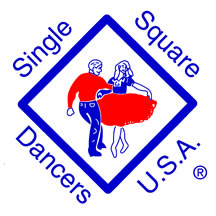
 |
Country Barns, haystacks, fiddle music, and farmers in overalls; that's the image most people have of Square Dancing. Those people are always surprised when they see how our National Dance has come of age. Today's dancers move to modern music, they meet in air-conditioned schools and recreation department halls, and they come from all walks of life. A pleasant mix of Classic Rock, Top 40, Country, Latin, and "Oldies" is used at most Square Dances today. Dancers might be promenading to "Pink Cadillac" one minute, and circling to "You Are My Sunshine" the next. In short, everyone can find their favorite music at a Square Dance today.
Just as the music is a blend of styles, so are the dancers, with everyone from company presidents to unemployed, and from student to retired, all having a good time together. It doesn't matter who you are, or what you do, just that you like having a good time with friendly people. There are square dance clubs on many college campuses around the country, and on many military bases, here and abroad. Single dancers dance together at Single Square Dance clubs in many cities. Square Dancing has often been described as "Fun and Friendship Set to Music". What better place for singles to meet each other for a relaxing evening of fun? No matter where you travel, here or abroad, you are never a stranger at a square dance club.
Today's Square Dancing is a combination, and evolution, of the folk dances of many parts of Europe. The Morris dancers of early England are the first ancestors. These dancers were groups of six men who danced various, vigorous patterns. From the Morris dances came the English Country Dance, performed on the lawns by great circles of many couples. A significant variation of the Country Dance was the "Longwayes for as many as will", which was performed in line formation.
Another ancestor of today's dance is the French Court Dance, or Branle. The Court Dance was performed in great ballrooms, by elaborately dressed couples. They danced in great circles, much like the English Country Dance, only with greater flourishes and whirls. As these dances moved to the French country side, the more robust moves of the English dances, particularly the Longwayes, were incorporated. This modified court dance had one couple after another dance the same figure over and over, a format which should be familiar to all Square Dancers today.
The French are also responsible for the Contre (or Contra) Dance, performed in two facing, or counter, lines of dancers. The Cotillion (meaning great petticoat) also came from the French dancing masters. These two dances evolved into the Great Quadrille, performed by four couples in a four sided set. The Quadrilles also used a prompter, the ancestor of today's callers, to announce the next set.
The settling of America began in the New England and Virginia-Carolina areas. Dancing didn't follow too quickly, due to the Puritanical influence. It wasn't until the early 1700's that any dancing surfaced. The "New England" dance was a hybrid of the English Country dancing and the French Court dances, soon evolving into a form of the Quadrille. The most common chorus then, as now, was ... Allemande Left and Right and Left Grand!
Paralleling the evolution of the New England Dance was the dance of the early settlers of the Virginia-Carolinas area, the Appalachian Mountain Dance. This was a vigorous, fast dance, much like the English Morris dance. A variation was the Running Set, or Big Circle Dance. The first couple would go to the second couple and execute a figure, then proceed to the next, and so on around the circle. This Running Set had a "prompter" too, who called the figures from within the set. As the country grew and expanded, the Quadrilles of New England merged with the Appalachian Mountain dances, forming the basis for today's Square Dancing.
Square Dancing has changed a lot since Colonial times. Gone are the fiddlers and live bands, replaced by sophisticated sound systems and recorded music. The barns and fields have given way to modern air-conditioned halls, with larger dances being held in Hotel Ballrooms and major municipal convention centers. Weekly dances at local Square Dance clubs average 50 to 150 dancers, with special weekend dances being attended by 500 to 3000 dancers. A "National" festival is held in a different city each June, and is usually attended by over 20,000 dancers.
Round Dancing is another important part of many Square Dance clubs. "Rounds" are very much like ballroom dances. The dancers, in couples, dance in a circle, hence the name Round Dancing. The movements are similar to ballroom dancing steps, with Waltz, Cha-Cha, Fox-trot, Swing, Two-step, and other rhythms being used. A Cuer, much like a caller, prompts the dancers as they glide across the floor.
While the dancing has seen many changes throughout the years, one thing has remained constant, the fun and fellowship. Each year, usually in September, Square Dance clubs throughout the world invite new dancers to join them. Groups are formed for the "beginners", where they can have fun while learning the movements the callers will call. After dancing a few months with other beginners, the new dancers will progress, or graduate, to where they can dance comfortably with others throughout the world. For more information on Square Dancing, contact your local Parks & Recreation, or find your closest club at the Western Square Dancing web site.